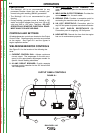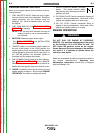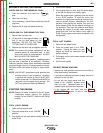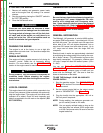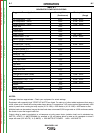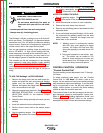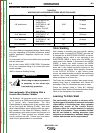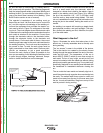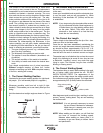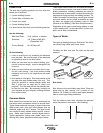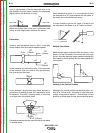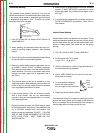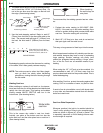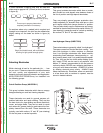
OPERATION
B-11 B-11
BULLDOG® 140
The function of the covered electrode is much more
than simply to carry current to the arc. The electrode is
composed of a core metal wire around which has been
extruded and baked a chemical covering. The core
wire melts into the arc and tiny droplets of molten metal
shoot across the arc into the molten pool. The elec-
trode provides additional filler metal for the joint to fill
the groove or gap between the two pieces of the base
metal. The covering also melts or burns in the arc. It
has several functions. It makes the arc steadier, pro-
vides a shield of smoke-like gas around the arc to keep
oxygen and nitrogen in the air away from the molten
metal, and provides a flux for the molten pool. The flux
picks up impurities and forms a protective slag. The
principle differences between the various types of elec-
trodes are in their coatings. By varying the coating, it is
possible to greatly alter the operating characteristics of
electrodes. By understanding the differences in the
various coatings, you will gain a better understanding
of selecting the best electrode for the job you have at
hand. In selecting an electrode, you should consider:
1. The type of deposit you want, e.g., mild steel, stain-
less, low alloy, hardfacing.
2. The thickness of the plate you want to weld.
3. The position it must be welded in (downhand, out-
of-position).
4. The surface condition of the metal to be welded.
5. Your ability to handle and obtain the desired elec-
trode.
Four simple manipulations are of prime importance.
Without complete mastery of these four, further
attempts at welding are futile. With complete mastery
of the four, welding will be easy.
1. The Correct Welding Position
Illustrated is the correct welding position for right-hand-
ed people. (For left-handed people it is opposite.)
Whenever possible, weld from left to right (if right-
handed). This enables you to see clearly what you are
doing.
Hold the electrode at a slight angle as shown in Figure
5.
Figure 5
15-20
90
side view
end view
Correct Welding Position
2. The Correct Way to Strike An Arc
Be sure the work clamp makes good electrical contact
to the work.
Lower your headshield and scratch the electrode slow-
ly over the metal, and you will see sparks fly. While
scratching, lift the electrode 1/8” (3.2mm) and the arc
is established.
NOTE: If you stop moving the electrode while scratch-
ing, the electrode will stick. Most beginners try
to strike the arc by a fast jabbing motion down
on the plate. Result: They either stick their
electrode or their motion is so fast that they
break the arc immediately.
3. The Correct Arc Length
The arc length is the distance from the tip of the elec-
trode core wire to the base metal.
Once the arc has been established, maintaining the
correct arc length becomes extremely important. The
arc should be short, approximately 1/16 to 1/8” (1.6-
3.2mm) long. As the electrode burns off, the electrode
must be fed to the work to maintain correct arc length.
The easiest way to tell whether the arc has the correct
length is by listening to its sound. A nice, short arc has
a distinctive, “crackling” sound, very much like eggs
frying in a pan. The incorrect, long arc has a hollow,
blowing or hissing sound.
4. The Correct Welding Speed
The important thing to watch while welding is the pud-
dle of molten metal right behind the arc. DO NOT
WATCH THE ARC ITSELF. The appearance of the
puddle and the ridge where the molten puddle solidi-
fies indicates correct welding speed. The ridge should
be approximately 3/8” (9.5mm) behind the electrode.
Most beginners tend to weld too fast, resulting in a thin,
uneven, “wormy” looking bead. They are not watching
the molten metal.
IMPORTANT: It is not generally necessary to weave
the arc forward, backward or sideways.
Weld along at a steady pace, and you
will have an easier time.
NOTE: When welding on thin plate, you will find that
you have to increase the welding speed,
whereas when welding on heavy plate, it is
necessary to go more slowly to ensure fusion
and penetration.
Ridge where puddle
solidifies
Molten puddle
Return to Section TOC Return to Section TOC Return to Section TOC Return to Section TOC
Return to Master TOC Return to Master TOC Return to Master TOC Return to Master TOC



